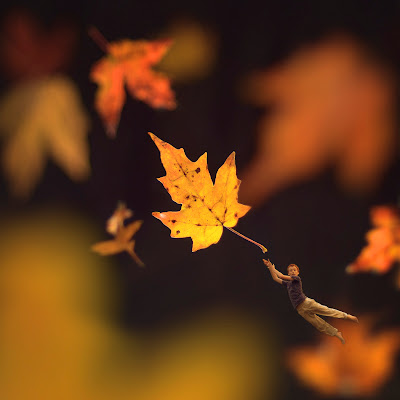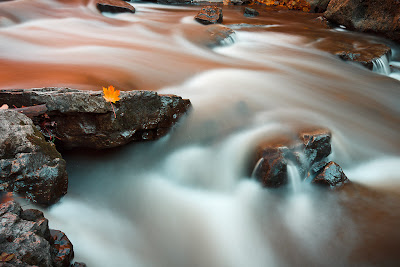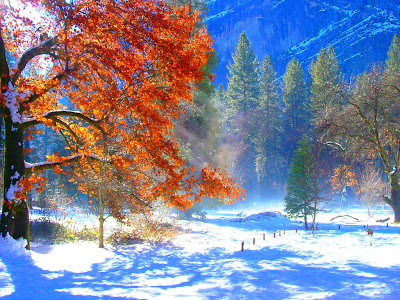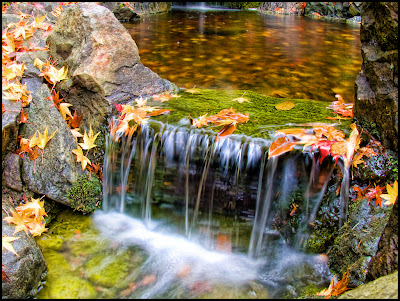 |
| Photo by: Wen Nag |
Autumn comes between summer and winter (from September to November); tourists flock to even remote places where there is better show of color. Trees shed their leaves to face winter –the tough season of the year- nature adds a variety of colors to those leaves due to fall.When detached from their branches millions of multicolored leaves perform a group dance in the wind before touching the ground. The falling of yellow, brown and golden leaves makes Autumn the most photogenic season of the year. For photographers autumn is a great season; they can harvest any number of stunning images.
Fall Foliage / Autumn Leaves – what does it mean?
 |
| Photo by: Edgar Barany C |
Autumn leaf color is a phenomenon that affects the normally green leaves of many deciduous trees and shrubs by which they take on, during a few weeks in the autumn season, one or many colors that range from red to yellow. The phenomenon is commonly called fall colors and autumn colors, while the expression fall foliage usually connotes the viewing of a tree or forest whose leaves have undergone the change.
Why Do Leaves Change Color in the fall?
 |
| Photo by: Trey Ratcliff |
The leaves of trees and other plants contain three main pigments: carotene, anthocyanin, and the photosynthetic pigment known as chlorophyll which gives green color to leaves. Another chemical in leaves is auxin which controls plant-growth and inhibits abscission layers. In fall, however, cooler and shorter days trigger an end to auxin production, allowing the abscission layers to grow and cut off the circulation of water and nutrients to the leaves.
When this happens, chlorophyll disintegrates rapidly, letting carotene shine through as the yellow in maple, aspen and birch leaves. Anthocyanin, meanwhile, provides the oranges and reds of maples, sumacs and oaks. When there’s less sun, anthocyanin isn’t as chemically active and leaves are more orange or yellow than red.
Tips for Photographing Autumn Leaves
 |
| Photo by: TM Pacheco |
As autumn leaves turn from summer green into a palette of warm colors, We will look at ways to maximize our autumn shooting potential and get the very best out of this colorful season.
How to Photograph Autumn Leaves - Technical Tips
Great photography is a unique mix of right technique and artistry. The peculiarity of fall / autumn season is the abundance of colors; let us go through the technical sides so as to effectively capture these vibrant hues.
Shoot RAW
 |
| Photo by: Steve Wall |
Always use RAW as your file format when photographing autumn leaves, shooting RAW will help you capture more information, greater dynamic range and also gives you the ability to experiment with different white balance settings in post production.
Use Neutral or Faithful Picture Style
 |
| Photo by: Morbcn |
When photographing autumn leaves, take care to cross check both the luminescence and RGB histogram; you may clip one or more colors without noticing. In this case since the subject / scenes already saturated with colors there is no need to add in any camera enhancements. My recommendation is to capture the picture using neutral or faithful picture style. Even though the picture will look muted when viewing on the LCD, it will prevent color clipping to an extent.Color, contrast, saturation, sharpness etc. cab be adjusted during post- production.
Use a Polarizing Filter
 |
| Photo by: Evan Leeson |
A polarizing filter will help to reduce reflections on the surface of the leaves there by allowing capture of more detail; they are also useful for increasing the saturation of colors.
Underexpose to Increase Saturation
Underexposing the shot by 1/2 to 3/4 stop will help in increasing color saturation in your fall foliage.
Clean the Leaves
If you are planning to shoot macro to capture the details of the leaf, it is a good idea to brush or wash any dirt off the leaves; unless you want them this way, a leaf could either photographed as wet or dry; drying it need care so that they don’t split.
What to Photograph in Fall? – Some Creative Inspiration
 |
| Photo by: Fiddle Oak |
Generally there are two options one is to get closer and put your macro lens to good use by capturing detailed leaf shots; second option is to take a few steps back and use your wide angle lens to take in a Technicolor landscape. Here are a few more ideas to set your imagination run free.
Take leafy portraits
 |
| Photo by: Edgar Barany C |
Perhaps it is time to test your portrait photography skills too, think of opportunities for capturing great portraits with a little bit of environment and emotion. Leaf fights, leaf forts, leaf heaps… they’re fun and the spontaneity will give you plenty of opportunity for capturing dynamic portraits.
Shoot Wildlife
Fall is the perfect time to capture wildlife in their natural environment, among the rich colors.
Capture Time Lapse of a Tree Changing
You can capture a time lapse of a tree changing during fall by taking a photo of the same tree, from the same spot, once every day for the next month. Take the shots from the same place and around the same time every day if you can, and watch as the tree slowly transforms before your eyes.
Try Painting with Shutter Speed
The technique of painting with shutter speed is quite simple. All you need is a camera on which you could set slow shutter speeds. It is really hit or miss affair, but when things really come together, results could be truly amazing, especially when you have such colorful subjects like autumn leaves to paint with.
Shoot Panoramas
Fall is a great time to experiment with shooting panorama; perhaps the most sought after among autumn photographs are the sprawling mountain vistas of color. Try to capture an expansive landscape rich with colorful fall foliage as a panoramic stitch. Shooting and editing panoramas are quite simple if you know the right technique; here’s a simple tutorial on how to shoot panoramas.
Experiment with Slow Shutter Speeds
 |
| Photo by: Gary Simmons |
Go creative with your camera by using slow shutter speeds to capture movement in a more surrealistic way, leaves swaying in the wind, leaves or small branches falling from the tree etc present a photographer with excellent opportunities to experiment with slow shutter speeds. One could also try to capture the movement in water along with the colors of the fall foliage in the background. To make slow shutter speeds possible during day requires ND filters.
Bokeh
A wide aperture lens like the 50mm f/1.8 commonly called normal lens could be a very powerful tool. Autumn colors are perfect for creating breathtaking bokeh backgrounds. Set your lens to its widest aperture, focus on your subject and capture amazing mosaic of shapes and tones as the background, a perfect setting for an outdoor portrait session.
How to Photograph Autumn Leaves – Artistic Tips
 |
| Photo by: Rhisiart Hincks |
Now that we have covered the Technical Side of Photographing Autumn Leaves and also looked into various creative ideas, now let’s look at the more artistic side of photographing fall foliage.
Finding the Perfect Location to Photograph Fall Foliage
 |
| Photo by: Eric |
Find the perfect location which not only has a wealth of trees but also of different species, as different species of trees will change color differently and at different times, so you have a wide range of colors to capture. While searching for a good location to shoot fall foliage aside from heavily wooded areas, consider urban or residential areas which feature trees like parks, walkways etc.
Need not Always Choose a Flawless Specimen
While discussing flower photography, we emphasized the importance of choosing a flawless specimen, but when photographing leaves this is not always applicable, sometimes small flaws on the leaf could actually add to its character.
Perfect Lighting for Photographing Autumn Leaves
 |
| Photo by: Edgar Barany C |
Try to photograph autumn leaves either early in the day before sun has completely risen over the horizon or later after the sun has set. These hours are called the golden hours due to the slightly golden tinge sunlight possess at that time. It gives a slightly warm feel to the image and also boosts the yellows, oranges and reds.
It is not advisable to photograph autumn leaves during mid day when the sun is shining brightly as the harsh sunlight washes away all traces of color from your images.
Another great time to photograph autumn leaves is during an overcast day. Light during an overcast day is soft. It lets you capture the details in the leaves and renders saturated colors.
The Right Background for Photographing Autumn Leaves
 |
| Photo by: Tony Hammond |
The background can make or break the shot. Subjects with muted colors are best photographed with subtle shades of grey as background; even white or black will do. But very colorful subjects like autumn leaves are best photographed against contrasting backgrounds. Look for color contrasts, such as bright red trees against an evergreen background or deep blue sky.
Avoid busy backgrounds
A cleaner, simpler background without any distracting elements to compete for the viewers’ attention works well all the time. One could either change the angle of view to get the right background or use selective focus along with shallow depth of field to render the background in a smooth.
Perspective
 |
| Photo by: Wbirt1 |
Perspective can be creatively used to achieve great results. A telephoto lens can compress various elements in the frame to make it feel like being on the same plane. Whereas a wide angle lens can exaggerate the scene and give more prominence to the foreground elements making everything else in the picture appear minuscule in comparison!
Composition Tips for Photographing Fall Colors
Simplify Simplify Simplify
Make your composition as simple as possible, practice the art of elimination, only include those elements that actually contribute towards the picture and have no mercy on distractions. You could either move in close to eliminate distracting elements or use a wider aperture to render them out of focus.
Capture Unique Perspectives
 |
| Photo by: TM Pacheco |
Don’t just photograph from your eye level, that’s how we see the world and that’s how 99% of the photographs are taken. Changing your shooting angle from eye-level to up high or down low can provide a unique perspective that may give the scene an entirely different feel.
Hijack Some Autumn Leaves
 |
| Photo by: Evan Leeson |
Take some colorful leaves home; they may come in to use in your compositions as anchor points or as center of interest. Positioning a leaf or two in a unique way could help transform an otherwise bland composition to a very interesting one. This works especially well with wide angle lenses.
Seasons come and go but the images they give last and last; looking at a well captured image can make the viewer shiver with cold in a summer day! So the grief stricken big big girl sung looking at the falling autumn leaves
“I can see the fresh leaves falling all yellow and nice;
It’s so very cold outside; like the way I am feeling inside.
Buck up dear; opportunities never end!
Post a Comment